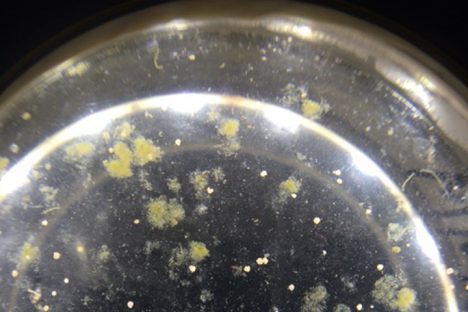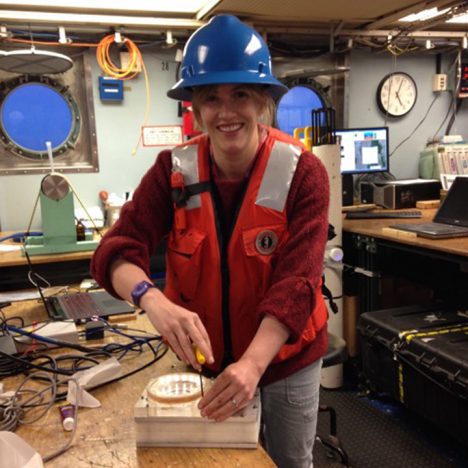

Researchers in the Dry Lab are able to examine the most recent Virtual Reality simulations created from holographic photos taken in each CTD cast. With this experience, it is clear that every single drop of water in the ocean contains huge amounts of life. Microscopic organisms constantly carry out processes that maintain the atmosphere, air, food webs, and life as we know them. Yet humans are changing things quickly, and we do not have enough knowledge to determine what our future world may look like. Hugo Berthelot, biogeochemical oceanographer, is on Falkor to fill in some of the blanks.
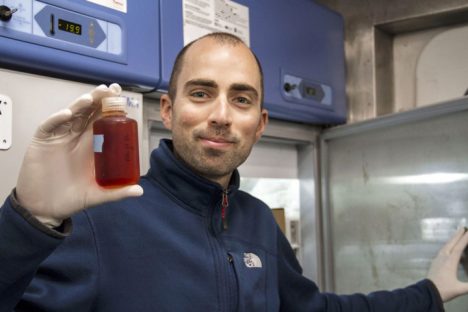
Hugo Berthelot, biogeochemical oceanographer, is on Falkor studying phytoplankton organisms and the biochemical processes they take part in.
Who is Doing What?
One crucial aspect of microbial communities that researchers want to understand can be summed up in the cheeky question “Who is doing what?” This is important to understand because of the delicate connections between all marine and terrestrial life, granting us a start to inferring the microscopic “winners” and “losers” in the face of Climate Change.
To do so, Hugo is studying the Nitrogen Cycle. Nitrogen is a key nutrient at the very base of the food chain, both on land and in the ocean. Its availability directly impacts the global marine ecosystem. Many microorganisms feast, grow, and live off of it. Once the microorganisms reach a certain size (or die), they will sink, dragging carbon – in the shape of organic matter – down with them. Once carbon leaves the superficial layers of the ocean and enters deep waters, it will be gone for thousands or even millions of years. As it stands today, a healthy functioning carbon sink is probably good news. This carbon pump has been working for thousands of years, helping regulate the Earth’s chemistry and temperature.
Understanding how available Nitrogen is for microbes to feed on, along with how different organisms are able to transform Nitrogen after they have ingested it, directly relates to the inner-workings of the biological carbon pump, Hugo’s main focus of research. He will collect water samples in very different geographical locations and weather conditions as Falkor sails from Hawaii to Portland, Oregon.
Invisible Gases and Microscopic Beings
Phytoplankton is very, very small. Studying which microscopic organisms transform an invisible gas (such as Nitrogen) and their rates at doing so is extremely challenging. Therefore, Hugo utilizes a special technology called nanoSIMS, but before he gets to that point, he must follow certain steps.

Using an incubator, Hugo Berthelot enriches the water with Nitrogen and exposes the microorganisms to this environment for 24 hours, to later assess how much Nitrogen each cell consumed.
He first collects water samples from the surface and from Niskin bottles deployed in CTD casts at the Deep Chlorophyll Maximum depth of 150 meters. The, using an incubator, he enriches the water with a stable form of Nitrogen (N15) while maintaining the microbial communities natural conditions, including light and temperature. After a day of incubation, he filters the water and freezes the samples, hence preserving each organism. Once back ashore, flow cytometry cell sorting will enable him to identify each kind of cell and sort them into taxonomic groups. Then nanoSIMS technology will detect the amount of N15 consumed by each cell. After months of rigorous and complex analysis, Hugo will be closer to understanding which organisms are carrying out certain chemical processes, as well as which ones are likely to benefit from changes in global climate.
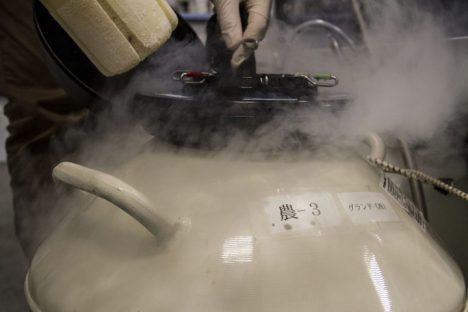
Hugo freezes the filtered samples using liquid Nitrogen. After leaving Falkor, he will analyze the cells to understand which chemical processes each one carries out and how they responded to the incubator experiment.
Every microorganism specializes in one single task, transforming one chemical element into another and fuelling our planet’s biochemical system. Therefore, changes in microbial populations will inevitably affect Earth’s chemistry. Once the snowball of a changing climate has begun rolling, it will trigger other factors – such as changes in oceanic microscopic ecology – which will in turn add to the snowball’s speed and impact. Figuring out what life inside a drop of seawater may look like in the future is essential knowledge for researchers to understand what the future may hold.

This is my instrument, which is designed to measure dissolved gases in seawater to detect the oxygen produced by algae. Sea Sparkle, my trusty green stuffed plankton assistant, is keeping a careful eye on the data we’re collecting!
When people think of science, the first examples that come to mind are often dramatic triumphs—the moon landing, the invention of DNA sequencing, or the discovery of the polio vaccine. Almost every exciting experimental result, however, is the result of an enormous amount of unseen effort. Thorough preparation, resourceful improvisation, success and failure, and improvement through trial and error are all deeply familiar to any researcher!
At sea on the Falkor, the challenges that we face as a part of ocean science are unique. After all, any unanticipated problems must be solved using only the resources on board our two-hundred-foot vessel.
Our first two days at sea have presented their fair share of challenges. Our cruise plans have changed almost daily in order to adapt to weather patterns and the ship’s limits in terms of speed and range. In the “wet” lab, anywhere from six to eight science team members must work elbow-to-elbow with all of their equipment packed into a space little larger than an examination room at the doctor’s office.
For my research, which involves measuring dissolved gases from seawater to detect plankton activity, plumbing has been my biggest enemy so far.
The seawater I am measuring is piped continuously aboard ship via a pump, and this water is available from only two outlets in the already-crowded lab. My original plan to use seawater from one of the two faucets was scuppered when a crucial valve broke, spraying the lab with ocean water like a fire hose! After shutting the faucet and confirming that none of our sensitive electronic instruments had been damaged, we realized that I would now have to take my water from the second outlet—located on the opposite side of the room from where I had set up my seawater supply tubing…! In addition to reorganizing all of my plumbing, I would also have to find materials to connect to the second faucet, which uses a different connection from the first.
Luckily, scientists can be pretty inventive! My seawater supply pipe was moved to hang from the ceiling in order to cross the room, and I borrowed parts from other members of the science team in order to fit my tubing to the new faucet. Sharing the lab space is also an important part of ocean science, and so Ryan, another scientist on board, graciously moved some of his equipment to give me access to the faucet.
When doing science at sea, it’s also important to learn from mistakes and bad luck quickly. This time, we fitted double metal clamps to the faucet connection to reduce the risk of unleashing a second fire hose event. With that final step, my plumbing was finally usable, allowing me to switch on my instrument and start collecting my valuable data!
In the end, we spent several hours fixing this incredibly boring problem—one which has very little to do with actual science. Paradoxically, however, all of our tinkering with tubes and faucets was essential in order to perform my research. This is just one of the many small challenges that we have dealt with as we prepare for one of the busiest parts of our expedition. Even though many of our problem-solving stories will never be mentioned when we publish our research results, they are just as much of a part of our science as designing experiments or picking locations for the Falkor to explore.
It’s little challenges like this that help me remember that every scientific discovery, great or small, is built on a huge foundation of invisible work!

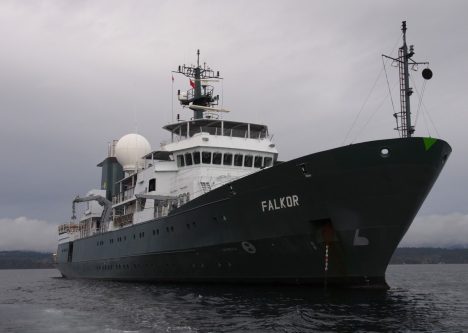
Research Vessel Falkor. Credit: Schmidt Ocean Institute
In just two short weeks I’ll be trading the cold, snowy beaches of Rhode Island for the warm, tropical beaches of Hawaii. Such is the life of an oceanography graduate student!
Although I do enjoy traveling and discovering new places, what’s most exciting is that I’ll have an entire month to conduct my research in the Pacific Ocean alongside some of the top scientists in optical oceanography. Together we’ll be looking at particles in the upper layers of the ocean during the Schmidt Ocean Initiative’s Sea to Space Particle Investigation aboard the R/V Falkor.
So what exactly will I be doing while I’m in the middle of the Pacific Ocean? Here are my top three activities at sea:
Going to sea is a lot like being at a high-end summer camp—someone cooks your meals and does your laundry while you spend almost all day engaging in an exciting stream of team activities. It’s a very social experience with many late night hours talking science and scheming the next experiment all while working on the most urgent area of science: climate change. I couldn’t be more excited.

